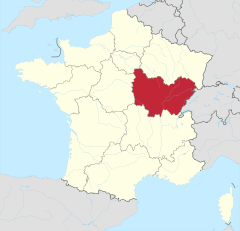Burgundia-Franche-Comté
| region | |||||
 | |||||
| |||||
| Państwo | |||||
|---|---|---|---|---|---|
| Siedziba | |||||
| Prezydent | |||||
| Powierzchnia | 47 784 km² | ||||
| Populacja (1.01.2020) • liczba ludności |
| ||||
| • gęstość | 58 os./km² | ||||
| Szczegółowy podział administracyjny | |||||
| Liczba departamentów | 8 | ||||
| Liczba okręgów | 24 | ||||
| Liczba kantonów | 152 | ||||
| Liczba gmin | 3831 | ||||
Położenie na mapie Francji | |||||
| Strona internetowa | |||||
| Portal | |||||
Burgundia-Franche-Comté[2] (fr. Bourgogne-Franche-Comté) – region administracyjny Francji. Stolicą administracyjną jest Dijon, siedziba Rady Regionalnej mieści się w Besançon.
Region został powołany z dniem 1 stycznia 2016 w ramach reformy administracyjnej z połączenia regionów: Burgundia i Franche-Comté.
Przypisy
- ↑ INSEE: Populations par région et département 2020. [dostęp 2020-03-30]. (fr.).
- ↑ Zmiany wprowadzone na 92. posiedzeniu Komisji (24 lutego 2016 roku). Komisja Standaryzacji Nazw Geograficznych poza Granicami Rzeczypospolitej Polskiej. [dostęp 2016-03-03].
Zobacz też
Media użyte na tej stronie
Autor: Superbenjamin, Licencja: CC BY-SA 4.0
Blason de Bourgogne-Franche-Comté
Autor: JGS25, Licencja: CC BY-SA 4.0
This building is indexed in the base Mérimée, a database of architectural heritage maintained by the French Ministry of Culture, under the reference PA00101450
Autor: TUBS
Location of region xy (see filename) in France as of Jan 2016.
Autor: Geraldiker, Licencja: CC BY-SA 4.0
Flag of the administrative region Bourgogne-Franche-Comté (with the gobbony error shown on the actual flag)








